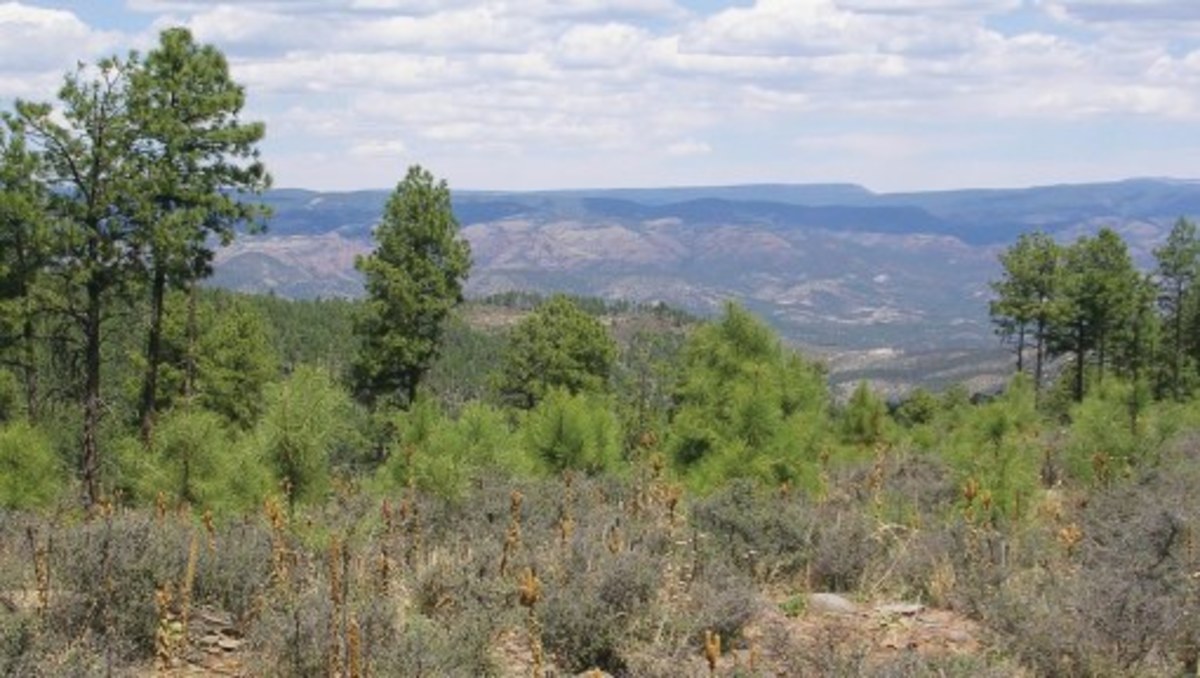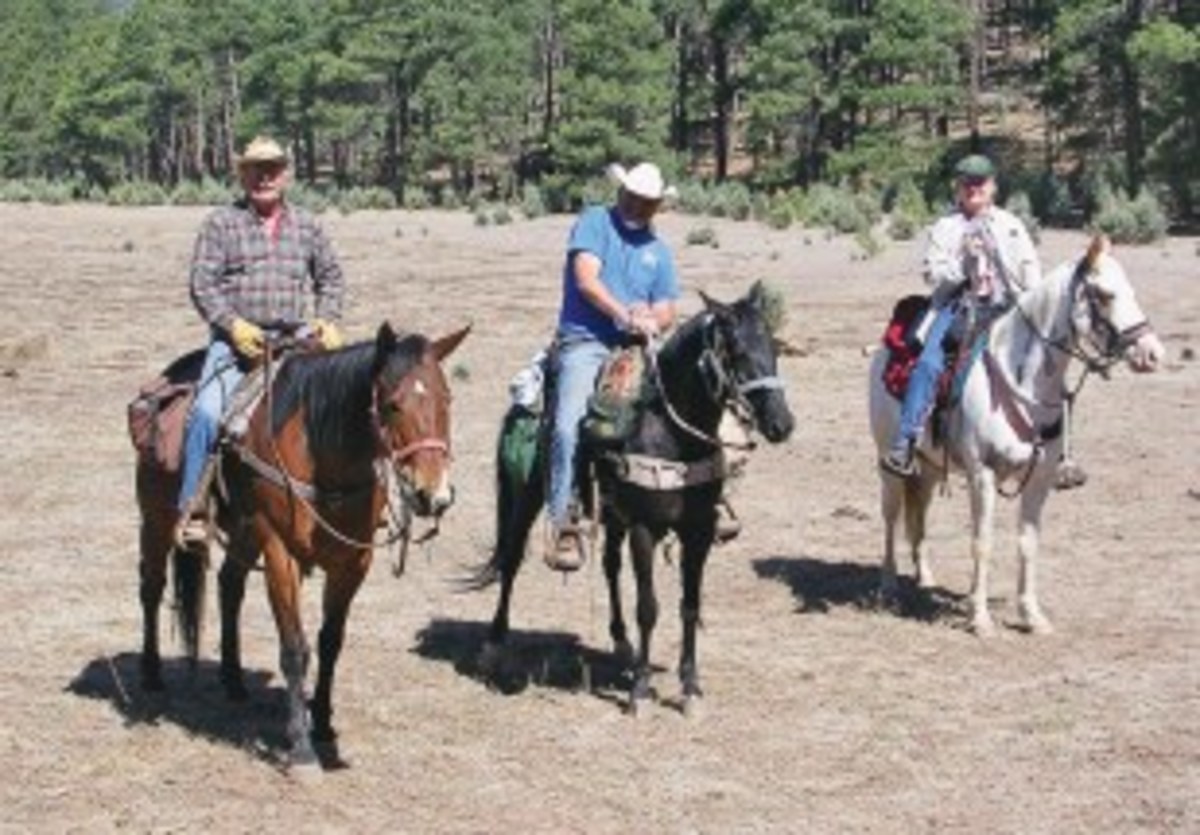Southwest Region
Last spring, I decided to take a trail riding pack trip somewhere in New Mexico. I found an advertisement in The Trail Rider for the horseback-adventure company U-Trail, The Gila Wilderness, located in Glenwood on the western edge of the Gila and Blue Range Wilderness Areas in southwest New Mexico. I chose late April/early May because the days were warm (mid-70s to low-80s), the nights were cool (mid-40s), and there wasn’t much chance for rain.

U-Trail’s owner/outfitter, Jim Mater, promptly answered my e-mail. Since I had no experience with a professional outfitter, I had no idea what to expect. Jim suggested I ride one of his horses; however, I was afraid a “dude ranch” horse would only stay head-to-tail and would be dull and lifeless, so I insisted on bringing my own horse. I chose my most broke, calm, and experienced trail horse, my 13-year-old Missouri Fox Trotter mare, Easter. I could trust her in any situation.
‘Pure Wilderness’
My destination was more than 900 miles from my home in Kansas, so I made reservations to stay overnight at the Empty Saddle RV Park in Tucumcari, New Mexico, the halfway point for me. The Empty Saddle is a nice, safe place to stay. It has electrical and water hookups, and a large horse pen. The owners live onsite.
When I arrived at U-Trail, Jim provided a nice pen for Easter, complete with hay and fresh water, and fixed me a hamburger. The U-Trail is located atop a mesa, with beautiful mountain views all the way around as far as you can see. This part of New Mexico is very desolate. Cell phones don’t work – you have to have a satellite phone.
Jim takes riders to different elevations, depending on the time of the year. This trip, we camped at around 6,000 feet, but rode up over 9,000 feet. We actually got to ride two states in one week: New Mexico and Arizona.
On Monday, we loaded up in Jim’s trailer and headed for the trailhead. All I had to bring was my sleeping bag, air mattress, clothes, and personal items. U-Trail provided food for me, feed for my horse, and a tent. Everything was packed on Jim’s stock. Since we were packing into a wilderness area, all horses are fed sweet feed and alfalfa pellets. It’d be a good idea to accustom your horse to this feed before the trip.
The trail to the base camp was beautiful, with huge juniper trees, pinion pines, and awesome mountain views as we dropped down in the canyon. The camp was shaded and had a nice creek running alongside it. Jim had already set up a dining-area canopy, a food-storage tent, and picket lines.
As we dropped into camp, we came from relatively flat terrain around a mountainside overlooking a valley that went down so far, I couldn’t see the bottom. The trail was just one-horse-width wide – no place for horses to act up. My flatland horse did fine following the pack string. However, my heart skipped a couple of beats when I saw the outside foot of Jim’s horse kick off the trail’s edge.
This area is pure wilderness. There’s no motorized-vehicle access, and we never saw any other trail riders. It’s important to hookup with a reliable guide who knows the terrain and can locate the scarce water sources.
Riding Adventures
After setting up base camp, we rode out to several places. There’s so much varied terrain and interesting rock formations, there’s no way you can get tired of any one trail. One ride took us for miles along a canyon, until we came out on a mountaintop. The canyon was so narrow in places, my knees were inches away from the rocky sides.

One day, we met up with a mother cow that had just had a calf in the canyon. Cows in this area are free-ranged and aren’t gentle. Jim had a heck of a time getting the cow to head up out of the canyon away from us, but he got the job done.
Another trail ran alongside some hoodoos – tall rock spirals. On one very narrow trail near the hoodoos, something snorted way above my head. Easter raised her head, flattened her ears, and became very tense. She tried to step sideways to get a better look toward the hoodoos, but there was nowhere to step. I took hold of the reins and asked her to stay going forward. She snorted and got a little jiggy, but otherwise stayed controllable. Jim thought the snorts might’ve come from a bull elk. I figured it was a ravenous mountain lion!
We stopped often in the shade to rest the horses, and I went looking for elk sheds and deer antlers. I found several. One wrangler, Paul, had analyzed where the elk would spend their spring days, shedding their antlers.
During one break, I went hiking, and before I knew it, I lost sight of the guys and horses. I found out really quick how insignificantly small I am in comparison to that country. Every rise I’d walk up wouldn’t look familiar. I whistled loudly, hoping Easter would hear and whinny back – but nothing.
I started to get panicky, because the last thing Jim told me when we headed out was “Don’t make me go into rescue mode.” I was getting really nervous. I stood on a huge, fallen pinion pine trying to get my bearings. I tried to get still and quiet and “feel” where my horse was. I felt like I needed to go to my left up a hill. I did so, and there was Easter and the guys! What a relief!
On the last day of riding, we rode to a place Jim called “Mystery Lake,” which he’d found in the early spring while clearing trail. There wasn’t any water in the lake this time, but it was an amazing place. It was well-wooded, as we were over 9,000 feet. The aspen trees were larger around than any I’d ever seen, and there were huge Douglas firs everywhere. Jim said it was an old-growth forest that had never been logged.
The day we packed out of our canyon and headed home, Paul saw fresh bear sign not far from where we were camping. The night before, we’d heard turkeys gobbling late into the night, which we thought was unusual. We wondered if the turkeys knew the bear was there.
Tough Terrain
I’ll definitely ride with U-Trail again and I’d recommend it to anyone. Next time, I’ll probably leave Easter at home. I didn’t realize the risk I took in taking a flatland horse into the high country. Easter did well, but Jim told me that usually flatland gaited horses don’t do as well as mine did, as they’re not used to the altitude and tough terrain.
I spent three months conditioning Easter for this trip, and I knew she was broke enough to go slowly, if necessary. I also knew I could depend on her surefootedness and level-headedness.
Jim’s horses are good-mannered horses in good shape. They’re not your typical “dude ranch” horses. I’d recommend riding one of his rather than taking your own. He’ll plan the trip to accommodate your riding experience and ability. If he sees you’re an experienced rider, he’ll take you on a challenging ride. If you’re inexperienced or would rather ride on gentler terrain, he’ll make that possible.
In the 15 years U-Trail has been in business, no guest has sustained major injuries on a pack trip. My trip was a once-in-a-lifetime, magical experience. I actually felt as though I left a part of my soul out there – which just means I’ll have to go back again and again to find it!
For more information on U-Trail, The Gila Wilderness, call (800) 887-2453 or (505) 539-2426, or visit www.utrail.com. For information on Empty Saddle RV Park, call (505) 461-8623, or visit www.emptysaddlerv.com.






